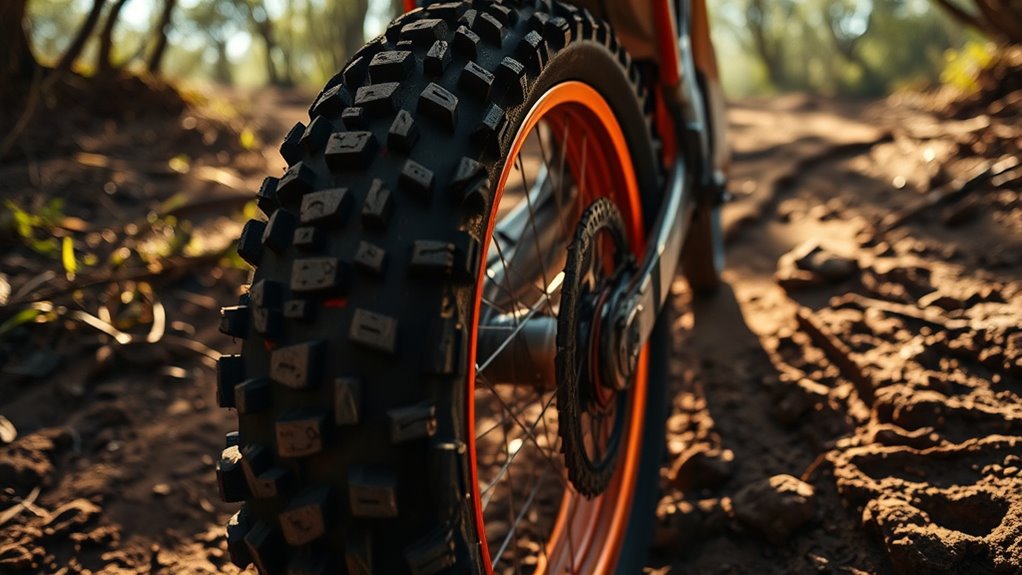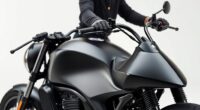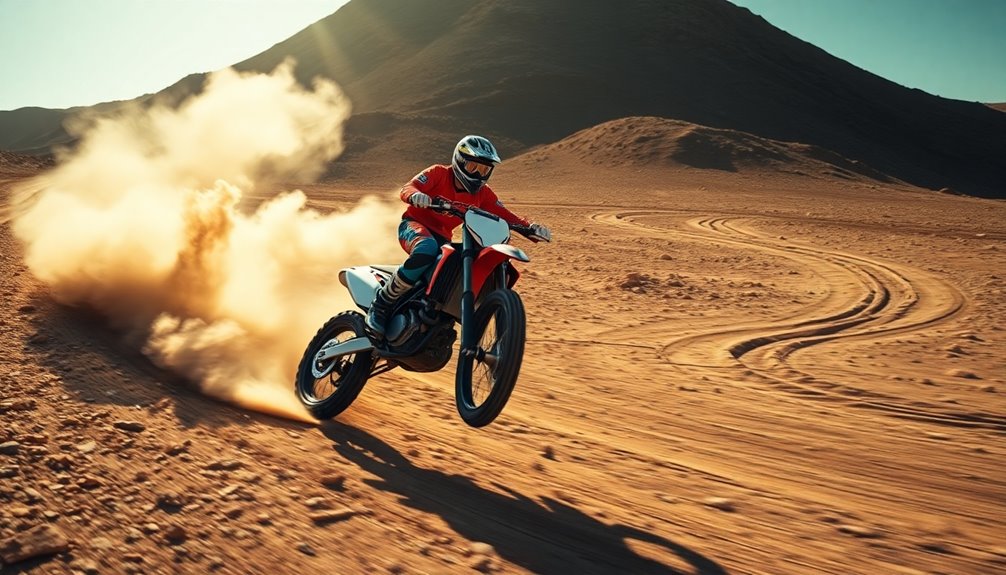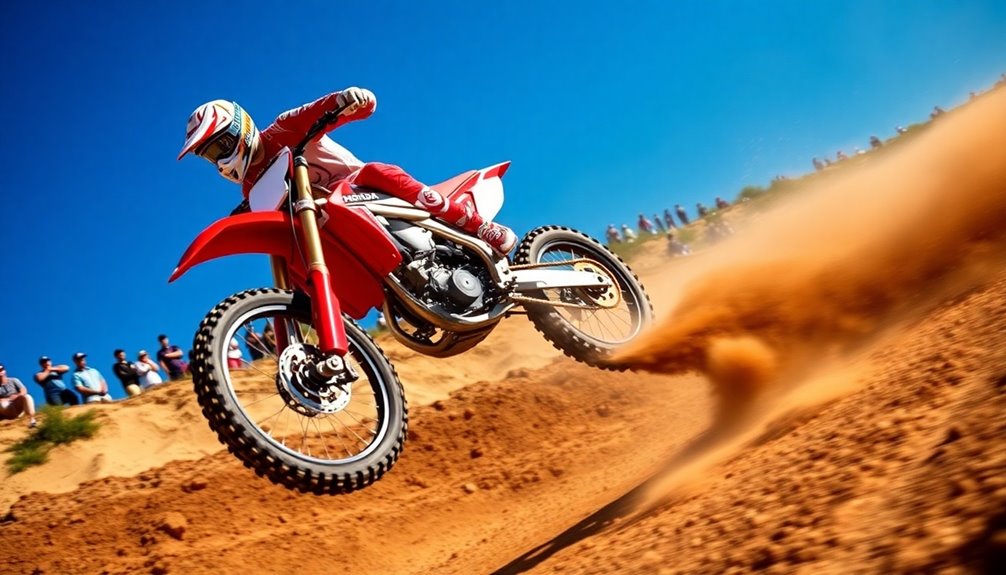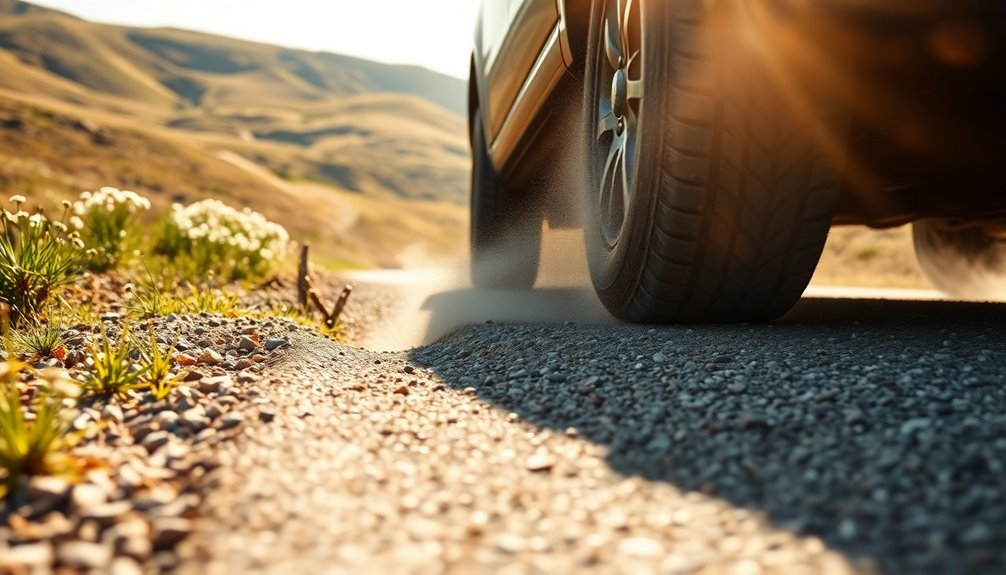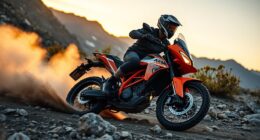To choose the right tires for dirt biking, consider the terrain you’ll mostly ride on. For muddy trails, go with tires that have wide, spaced-out lugs that shed mud easily. On sandy surfaces, paddle-style treads work best for digging in. Hard-packed dirt calls for smaller, tightly packed knobs to improve grip. Always adjust your tire pressure based on terrain for maximum control. Keep exploring to discover how matching tires to your riding style can boost your confidence and performance.
Key Takeaways
- Match tire tread patterns to terrain, such as wide lugs for mud or paddle designs for sand.
- Adjust tire pressure based on terrain for optimal grip and handling.
- Choose tires with appropriate durability and grip for your riding style and terrain conditions.
- Regularly maintain and inspect tires for wear, proper inflation, and damage to ensure safety.
- Opt for versatile tires if riding across multiple surfaces, or terrain-specific tires for specialized conditions.
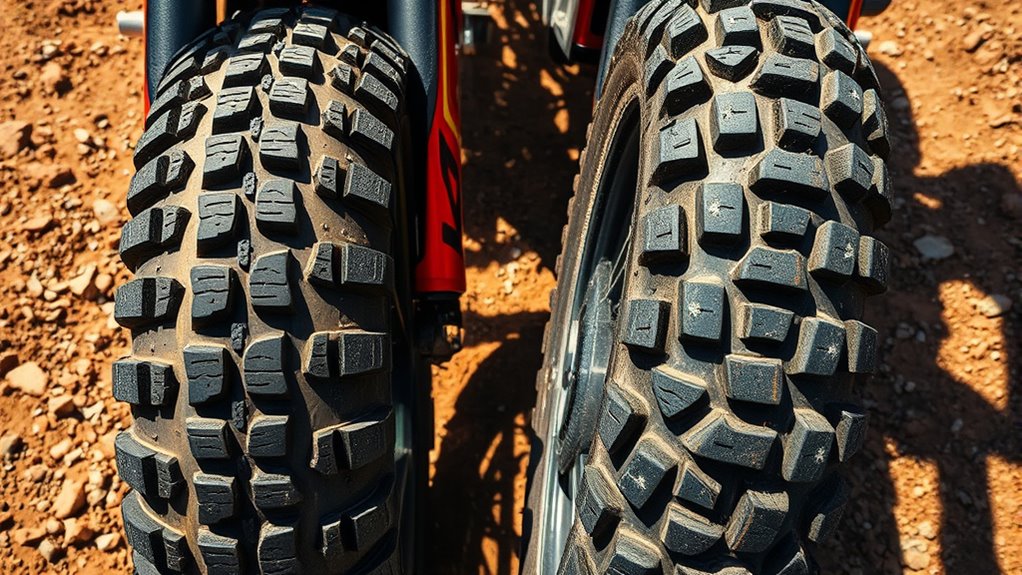
Choosing the right tires for dirt biking is essential for maximizing performance and safety on challenging terrains. Your tires are your primary contact with the ground, so getting them right makes all the difference. One of the first things to contemplate is tire pressure. It might seem minor, but adjusting tire pressure to suit the terrain can markedly improve your bike’s grip and handling. Lower pressure increases the tire’s contact patch, giving you better traction on loose or uneven surfaces like mud, sand, or gravel. Conversely, higher pressure helps when riding on hard-packed dirt or rocky trails, providing stability and reducing the risk of pinch flats. Always check your tire pressure before hitting the trail, and don’t be afraid to make adjustments based on conditions. It’s a simple step that can boost your confidence and control.
Next, pay close attention to tire tread patterns. Different terrains demand different tread designs, and choosing the right pattern can make or break your ride. For muddy trails, look for tires with wide, spaced-out lugs that shed mud easily, preventing build-up that could cause you to slip. If you’re tackling sandy terrain, you’ll want a tire with paddle-like tread patterns that dig into the loose surface, offering better propulsion. For rocky or hard-packed dirt, choose tires with smaller, more tightly packed knobs that provide a firm grip without sacrificing stability. The key is matching the tread pattern to the terrain’s demands to optimize traction and control. Remember, tires with aggressive, deep lugs aren’t always better—they can increase rolling resistance on smoother surfaces, making your ride less efficient. Additionally, tire maintenance is crucial to ensure optimal performance and longevity of your dirt biking tires.
Ultimately, your choice of tires should reflect both the type of terrain you’ll encounter and your riding style. If you often switch between different surfaces, contemplate versatile tires with moderate tread patterns designed for multi-surface use. Always pay attention to tire pressure and adapt it to match conditions, and select tread patterns that are suited for the terrain you’re riding on. Properly inflated tires with appropriate tread patterns will help you maintain better control, reduce fatigue, and increase your safety. Never underestimate the importance of good tires—they’re the foundation of your dirt biking experience. By making informed choices, you’ll enjoy smoother rides, better grip, and more confidence on every trail you conquer.
Frequently Asked Questions
How Often Should I Replace Dirt Bike Tires?
You should replace your dirt bike tires when the tread patterns show significant wear or the tire wear indicators become level with the tread surface. Typically, check your tires after every ride, especially if you ride frequently or on rough terrain. If you notice reduced traction, cracks, or flat spots, it’s time for new tires. Regular inspection helps guarantee ideal performance and safety during your rides.
Can I Use Street Tires for Dirt Biking?
You shouldn’t use street tires for dirt biking because their tire tread patterns and durability aren’t suited for off-road conditions. Street tires lack the aggressive tread necessary for grip on loose or uneven terrain, which can compromise your safety. While they may seem convenient, they wear out quickly and don’t provide the traction you need. Stick with dirt bike tires to guarantee peak performance, safety, and tire longevity on rugged trails.
How Do Tire Pressures Affect Performance?
You should adjust your tire pressures based on your riding conditions. Lower air pressure increases tire tread pattern contact with uneven terrain, giving better grip and control, while higher pressure reduces rolling resistance on smooth surfaces. By making air pressure adjustments, you optimize performance for different trails. Keep in mind, proper tire tread patterns also play a crucial role in traction, so match your pressure and tread for the best dirt biking experience.
Are Tubeless Tires Better for Dirt Biking?
You might find tubeless tires better for dirt biking because of their advantages like fewer flats and easier repairs. They also offer better tire compatibility, allowing you to run lower pressures for improved grip and shock absorption. Coincidentally, many riders notice enhanced performance and reduced weight, making tubeless setups a popular choice. So, if you want reliable, high-performance tires that adapt to tough terrains, tubeless options could be your best bet.
What’s the Best Tire for Muddy Terrains?
For muddy terrains, you want tires that excel in mud traction. Look for tires with deep, aggressive tread patterns that dig into soft ground and clear mud effectively. Wide spacing between tread lugs helps prevent mud buildup, ensuring better grip and control. Choose tires designed specifically for mud, as they offer the best performance in slippery conditions, giving you confidence and stability when riding through challenging, muddy trails.
Conclusion
Choosing the right tires is like finding the perfect dance partner on rugged terrain—trust your instincts and match your needs. With the right grip, durability, and tread pattern, you’ll glide over dirt and rocks as if you’re part of the landscape. Don’t settle for anything less than tires that embrace your riding style and terrain challenges. When you pick wisely, every trail becomes a canvas, and you’re the artist carving your path through nature’s wildest masterpieces.
